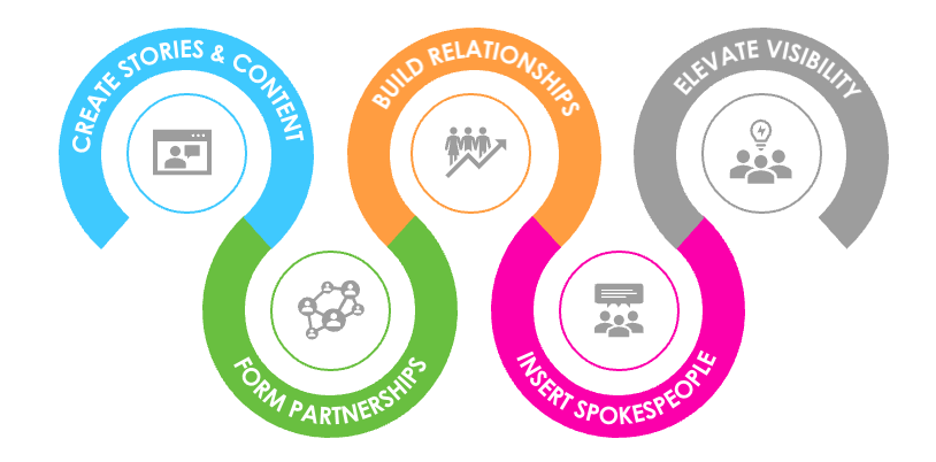As someone who has worked in media relations for more than 10 years, I can say with confidence that breaking into the news cycle is more challenging than ever— newsrooms are shrinking, outlets are fragmenting into smaller, niche outlets, social platforms that we’ve relied on for reporter commentary are crashing and the media is subject to increased public scrutiny. At the same time, the value of earned media continues to be top of mind for organization leaders, as we continue to see how recognition in the news can build reputation, expand thought leadership and drive impact.
Securing meaningful media coverage is an intricate art that requires a dedicated, experienced and nimble team. To land a strong placement that moves the needle for an organization, you need to be creative, flexible, persistent and, oftentimes, in the right place at the right time.
While we often talk about what drives news—such as practice-changing research findings or a surprising new trend—there are some core elements outside of the “news factor” that can strengthen your media relations success.
At CURA Strategies, we work in partnership with our clients to bring the following elements to life, to help elevate our clients and their core issues in the news.

Create Stories and Content
Understanding the real human stories behind a new innovative tool or a policy change that our client is working towards is vital to connecting with audiences on a deeper level and making the story stand out to reporters. Personal stories evoke emotions, and we need to go beyond the facts and statistics to ensure our messaging resonates.
Case in point: When we secured interest from a STAT News reporter in a Medicare policy change that restricted access to innovative blood tests that monitor the health of transplanted organs, we knew we needed to offer a strong patient story to illustrate the impact to care. Thankfully, we had already done our homework and had several conversations with Margaret Gamble, a kidney transplant patient and former state representative in South Carolina. Margaret’s ability to eloquently speak to the issue and the impact on her care was critical for the story that ran with her photo front and center: Transplant patients say new Medicare guidance puts their donated organs at risk.
Form Partnerships
Reporters like to garner many diverse perspectives when covering an issue. While forming partnerships with like-minded organizations is not always an obvious tactic for media relations—it can pay off. Whether it’s an organization with a similar mission, an influencer, practitioner on the ground or a thought leader in your field, these types of partnerships can help bolster your story and lend credibility to your message. Also, playing the role of convenor or connector for a reporter will set you apart as a valuable resource.
Case in point: Given CURA’s sole focus on health care, we can sometimes help facilitate partnerships or connections between our clients that are mutually beneficial. For example, when The Leapfrog Group was releasing its Hospital Safety Grades in the Spring, we knew this would be of interest to another client, Nozin, makers of Nozin® Nasal Sanitizer® antiseptic. The Safety Grades were focusing on a rise in hospital-associated infections (HAIs) during COVID-19, something that Nozin is helping to combat through nasal decolonization. In our conversations with media around the Hospital Safety Grades, we were able to identify opportunities for infection control experts to talk about the impact of nasal decolonization as one tool that hospitals are using to combat HAIs. Here is an example in Becker’s Hospital Review: Spike in HAIs should ‘stop hospitals in their tracks’: Leapfrog.
Build Relationships
Because our work focuses solely on health care, the issues we work on often intersect and we’re able to form deeper connections with health care reporters over time. In these relationships, it’s vital to build trust by being reliable and respectful and always going above and beyond to make a reporter’s job easier. By forming these connections, we can increase the chances reporters will want to work with us again in the future. Also, it’s important to remember that reporters are humans just like us, so we should think about what it’s like to be in their shoes when we consider how we can be most helpful.
Case in point: When Elaine Chen was writing for Bloomberg, she expressed interest in connecting with a kidney organization I was working with for future stories surrounding immunocompromised patients. I followed her move to STAT News, and, while her coverage focuses more heavily on research in the cardiovascular space, I thought she might be interested in a policy issue impacting transplant patients, who are immunocompromised and vulnerable in several ways. That initial connection paid off and she wrote a very impactful story.
Insert Spokespeople
Figuring out a diverse roster of spokespeople that can represent our clients and understanding their unique perspectives is vital to making news. A big part of our job is monitoring the news and “news jacking” or conducting reactive pitching to major announcements or happenings that are relevant to our client’s work. Having spokespeople prepped and ready to go for these instances is key to becoming part of the national conversation.
Case in point: When a reporter was looking for spokespeople to comment on racial disparities in the transplant field, I knew we had an opportunity to offer a strong voice for the Black community. Thankfully, in our work with the Honor the Gift coalition, we had built a diverse group of advocates who were ready to speak on behalf of the transplant community. One of those advocates, Tiffany Jones-Smith, the CEO of the Texas Kidney Foundation, offered insightful perspective around the impact of racial inequities in kidney care, and she was quoted in the story in Mother Jones: Congress is Finally Fixing the (Very Broken) Organ Donor Network.
Elevate Visibility
Once a media article or segment is placed, our job isn’t done. We need to leverage the media moment and amplify it’s reach among our key audiences by posting on social media, integrating into a website, featuring it in newsletters and member emails, notifying key partners and tracking the impact on website traffic. Additionally, companies should consider paid social media to boost the content. And, as AI continues to advance, you can consider experimenting with AI-generated content—such as generating a listicle or infographic that complements the story, offering a new format for continued engagement.
Case in point: When our client’s campaign, Mobilize Recovery Day of Service, was featured in a national CBS News story titled Nationwide “Day of Service” to honor people in recovery and give back to local communities, we leveraged it to bring credibility to a relatively new campaign. This included promoting on social media, sharing in external communications and featuring the story prominently on the organization’s homepage, so that any new visitors saw the top-tier media placement.
Developing an earned media program that elevates your organization’s reputation and moves the needle on your key issues takes a tailored approach that considers key news drivers along with the elements above to break through the noise.

Stephanie Wight
VP of Media Relations
CURA Strategies
